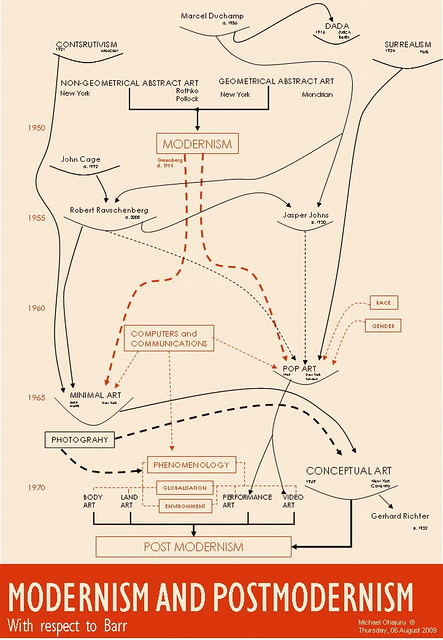Alfred H. Barr’s cover for 1936 Cubism and Abstarct Art Exhibition at MOMA is one of my favourite works I met so far on the course. Why ? Because it appears to be so logical:
Vertically - A distinct time line all progression, one thing leading to another.
The chart ignores any of the social , political or military circumstances which impacted art's developements during the period.
Horizontally – The shift from figurative to non-figurative or the opposite from non-geometric to geometric – making figurative the negation of geometric. En Route figurative art was abstracted
What’s missing or least I haven’t come across it is any kind of legend , explaining the significance of the red and black lettering , boxes and arrows the solid and dashed lines.
Here’s my take:
Font Size
The size of the font seems to indicate importance CUBISM is the biggest reflecting its pivotal importance in modern art with six connections the most influential ISM of the twentieth century. Interestingly FAUVISM is the most eclectic ISM with 5 influences.
Red Type
The red appears to indicate external influences while the black are internal
For example the impact of NEGRO SCULPTURE – Primitivism – on Fauvism where it simplified its compositions, Mattisse Dance, and Cubism where it moved it to abstraction.
(ABSTRACT)
Here Barr is indicating the ISM had other branches he is only concerned with its abstarct developments. For example EXPRESSIONISM has on the one hand figurative work by Matisse and on the other hand fully abstract pieces by Kandinsky which both have a common root in EXPRSSIONISM
Dotted Lines Black
BlackA dotted line seems to indicate a tentative relationship.
The lines from Redon to EXPRESSIONISM and SURREALISM are to me problematic need to proven.
Equally the all the dotted lines to MODERN ARCHITECTURE are questionable specifically the BAUHAUS link this one at least should be a solid line.
Red There is only one seem to indicate a tentative relationship between MACHINE AESTHETIC and Brancussi.
A dotted line seems to indicate a tentative relationship between Barancussi work and the machine which is odd because there was
a famous court case where Brancusi had to defend a work as art not domestic utensil to the US custom authorities.



